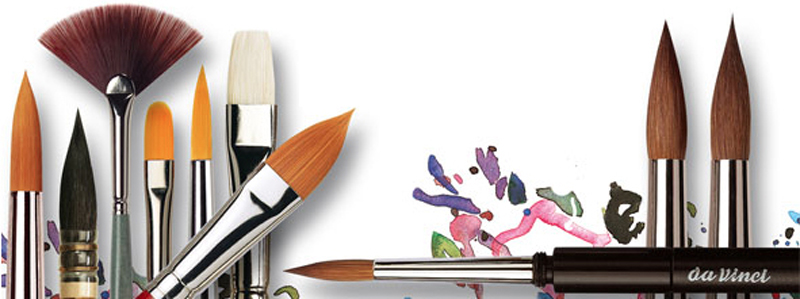We were very lucky to have had Melbourne artist Kez Hughes give a presentation about brushes in our shop last Saturday. Hughes is a practising realist oil painter who graduated from VCA in 2015 with a Bachelor of Fine Art (Hons). She has spent over 14 years working with the two major oil paint manufacturers in Australia and has gone on to lecture in Materials and Techniques at VCA and The Ian Potter Centre for Cultural Materials Conservation. She currently teaches at Fitzroy Painting and is co-director of CAVES, a curated, not for profit gallery located in the Nicholas Building.
Hughes began her presentation with talking about the different weights and shapes of the brush handle. The weight of the handle and its shape determines how it will sit in your hand and it consequently informs how you will be applying the paint onto the canvas. Short handled brushes imply that you would be sitting whilst working and long handled brushes are for standing up when painting.
Another important factor to consider when choosing brushes is the shape of the brush.
The most common brush shapes are the flat brush, round brush, filbert brush, fan brush, elongated rigger brush and mop brush. Each of these brush shapes gives you a different kind of paint application, depending on the paint medium you are using. For example, a round brush is great for watercolour painting and works well for washes and details. For thicker, heavy body paint, such as oil paint and impasto acrylic paint, filbert and flat brushes are more appropriate, as they provide a wider surface area for pushing paint around, allowing you to build up layers. Filbert brushes are particularly useful for wet in wet blending, while fan brushes are useful for glazing.

Once you have found the most suitable shape for what you wish to achieve with your chosen medium, you should consider available types of brush hair and how this will influence the appearance of your brush strokes on the canvas. Hog hair is the most common kind of animal hair used in brush manufacture. It is relatively inexpensive and feels coarse to touch and has resistance, resulting in visible brush marks. This can be useful for gestural work or if you want to create more painterly brush strokes. During her presentation, Hughes mentioned that once you have worked out what brush shape and what kind of hair will work best for you, it is a good idea to purchase several of the same kind, instead of getting side tracked by all the different brush options.
When it comes to choosing between brush brands, buying a brush that has been manufactured by a reputable brush manufacturer, such Da Vinci or Raphael, means that the brush will last the test of time. It also means that the brush has undergone strict quality testing. Brush-houses such as DaVinci, pride themselves in combining the best materials and traditional craftsmanship with technological progress. This means that combining craftsmanship with technology enables brush manufacturers to engineer and fine-tune brushes for optimum paint application. This is also reflected in the price level of the brush. It is therefore helpful to remember that purchasing a brush from an established brush maker, such as Davinci, Raphael or Omega, also supports a long history of brush-making tradition and helps to sustain and develop the craftmanship that has gone into producing the product.



